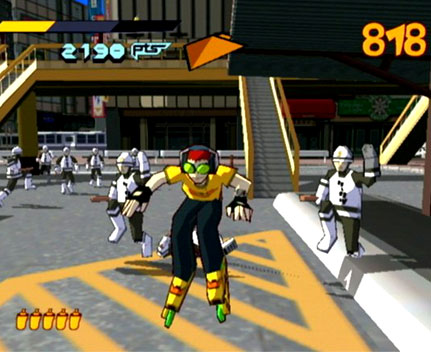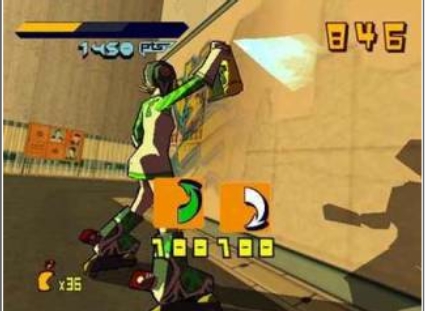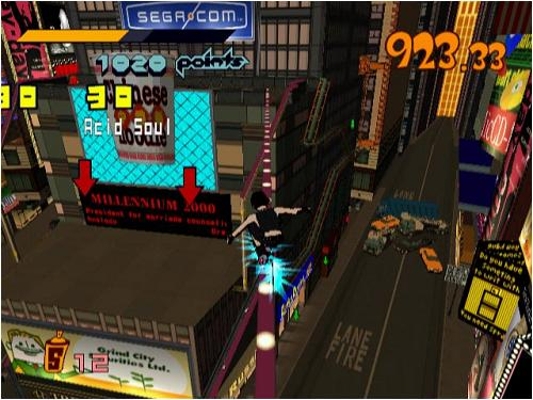Dreamcast Retrospective Day 1: Jet Grind Radio
 Tue, September 1, 2009 at 1:52 PM
Tue, September 1, 2009 at 1:52 PM 9/9/09 will mark the tenth anniversary of the beloved but short-lived Dreamcast, which entered our hearts on 9/9/99. As a tribute to this special console, Zestful Contemplation will be running nine days of nostalgia-tinted coverage of Sega’s last console. Enjoy.
Remember when cell shading was revolutionary?

Remember when nobody had seen it before? When a little game called Jet Grind Radio burst out of nowhere and showed gamers a brand new art style, unlike anything seen before?
Remember how wickedly cool it was? Remember how you marveled at how much like a 3D cartoon it looked?
Remember when the technique wasn’t only reserved for crappy licensed children’s games and could actually be considered a desirable art style?
The prominence of cell shading today is all thanks to Jet Grind Radio.
The glory days of cell shading may not have lasted long, as the style quickly faded into the realm of novelty except in exceedingly rare circumstances, but Jet Grind Radio showed us the style done right.
I don’t honestly remember whether Jet Grind Radio was technically the first cell shaded game on the market. It’s certainly the first one that I remember and I believe it was, but that’s not really what important. It’s not even worth looking up.
Why?
Because what’s really important is that Jet Grind Radio is the first cell shaded game that mattered.

More importantly, it was one of the few 3D games of its day to display a truly unique art style. With the PlayStation 2 came enough polygonal fidelity that it was actually possible to differentiate one blocky, multidimensional game from another. No one confuses Okami for Metal Gear Solid 3.
But Jet Grind Radio was one of the earliest examples that 3D games could truly innovate artistically; that they could bring something unique to the table.
These days artistic style is all the rage. Throwing more and more polygons has become so difficult and so expensive that developers are finally starting to focus on what really matters: the art style. From Braid to Shadow of the Colossus to Prince of Persia to Valkyria Chronicles, games are trying harder than ever to differentiate themselves from one another artistically.

For me, though, Jet Grind Radio was the first time that I was really convinced that my beloved medium of games could really do anything interesting artistically, though I admittedly might not have been able to put it quite as nicely at the time.
It didn’t hurt that the gameplay was just as unique as the art style. Large, open environments to wander around in provided a thrilling mixture of exploration, platforming, action, and even a little puzzle solving.
Anyone who ever got truly hooked into the game could tell you how much replay value it had, too. There was tons of stuff to collect and unlock and always another reason to pick the game back up and give it another go.
That was one damn hard game, though.
I have no shame in admitting that some of my most fond memories of the game come not from playing it myself, but from watching a close friend play and show off his far superior skill. We spent a ton of time together playing this game and it wasn’t even multiplayer. We just enjoyed watching each other explore the worlds.
Though it was usually him playing. He was better, what can I say?
Ok, fine, we used the occasional cheat code.
I said the game was hard.

Our love for the game spilled over to the much-ignored Xbox sequel (and in fact we’ve probably logged more time into that one than the original), but there’s something special about number one.
The soundtrack is like that of no other game I’ve heard before or since (save for the sequel). The gameplay still remains unique, even in the current gaming landscape full of open worlds begging to be charted and exploration to be had on every disc. There’s just something different about this one and the blend of disparate elements it offers. It’s more than the sum of its parts.
Incidentally, Jet Grind Radio featured perhaps the only implementation of a quick time event style gameplay element that I actually genuinely enjoyed (so much so, in fact, that I lamented the more streamlined gameplay of the sequel that cut out the feature in favor of more speed). Painting that stylish graffiti with button taps and circular motions was far more enveloping than simply holding down a button to paint, especially when you had a gaggle of bumbling cops quickly approaching.
Jet Grind Radio got me to truly like a button-matching gameplay segment.
I told you the game was special.


